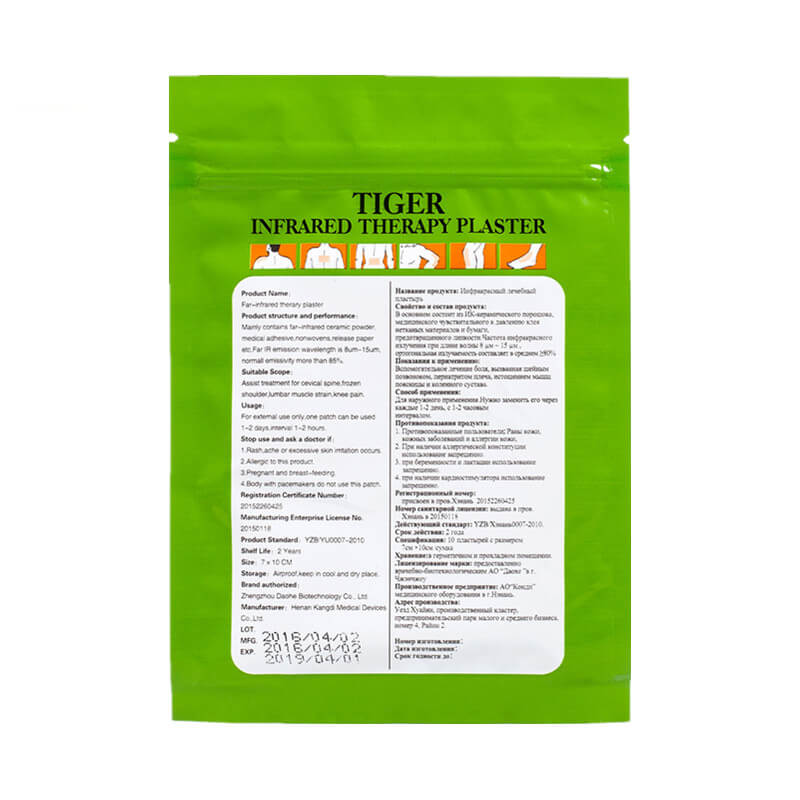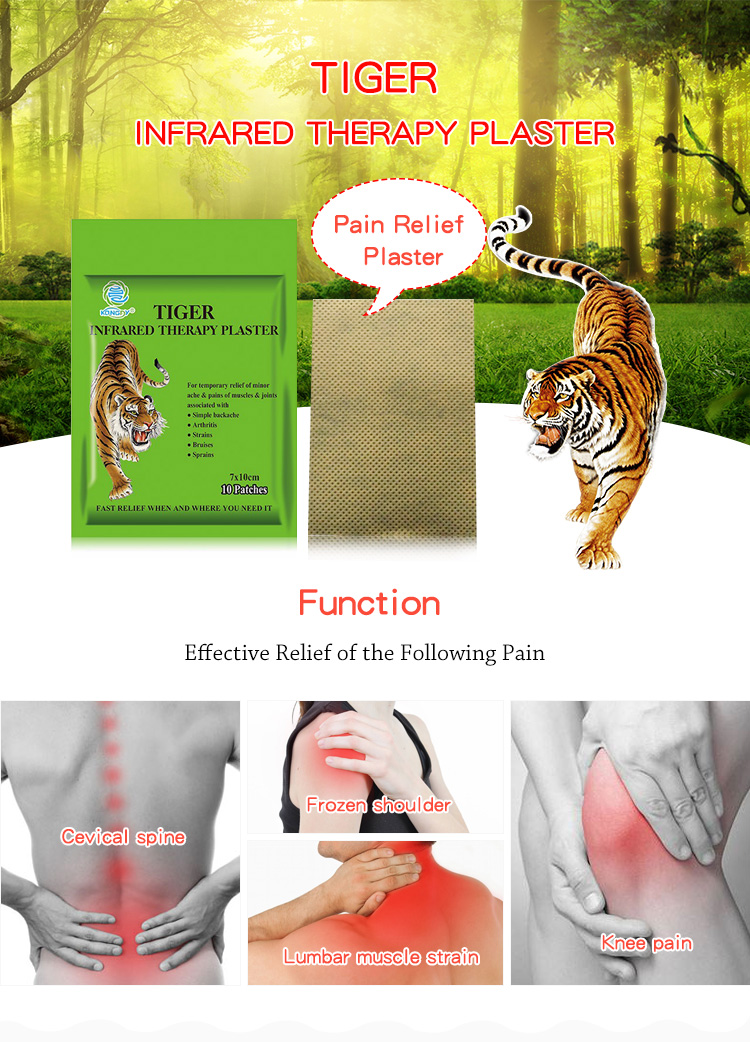From R&D to Market: The Story of Tiger Infrared Therapy Plaster in OEM Process
In today's competitive healthcare and wellness market, developing a successful product involves more than just a good idea. The journey from research and development (R&D) to market involves intricate steps, including design, testing, manufacturing, and distribution. For businesses interested in launching their own infrared therapy plasters, understanding the OEM (Original Equipment Manufacturer) process is crucial. This article explores the step-by-step development of a Tiger Infrared Therapy Plaster in the OEM process and provides insights on how businesses can benefit from partnering with a Tiger Infrared Therapy Plaster Manufacturer.
OEM partnerships allow businesses to outsource the production of high-quality products while focusing on branding, marketing, and sales. In the case of Tiger Infrared Therapy Plasters, these collaborations have produced highly effective products that meet market demand for natural pain relief solutions. Whether a company is developing a Custom Tiger Infrared Therapy Plaster or a Private Label Tiger Infrared Therapy Plaster, understanding the OEM process can pave the way for a successful market launch.

1. The Role of R&D in Developing Tiger Infrared Therapy Plasters
1.1 Research into Infrared Therapy Benefits
The development of any successful healthcare product starts with research. For Tiger Infrared Therapy Plaster Manufacturers, the R&D phase is focused on understanding the scientific principles behind infrared therapy. Infrared therapy works by emitting infrared radiation that penetrates deep into the skin, providing heat that helps to alleviate pain, reduce inflammation, and improve blood circulation. These benefits make infrared therapy a popular solution for people suffering from chronic pain, arthritis, muscle soreness, and sports injuries.
Understanding these therapeutic effects is key for developing a Custom Tiger Infrared Therapy Plaster that effectively addresses customer needs. The R&D team analyzes various materials, adhesive properties, and heating elements to ensure that the plaster provides sustained and safe heat delivery. This research-driven approach allows OEM partners to create highly targeted and effective pain relief solutions.
1.2 Product Design and Formulation
Once the research phase is complete, the next step in the OEM process is product design and formulation. Here, Tiger Infrared Therapy Plaster Manufacturers focus on selecting the right materials for both the plaster and the adhesive that will ensure the product is safe, effective, and comfortable for users.
OEM manufacturers often collaborate with their clients to design Custom Tiger Infrared Therapy Plasters that meet specific market needs. This may involve adjusting the plaster's size, shape, or adhesive strength to suit particular target demographics. Additionally, manufacturers ensure that the plaster is durable and easy to apply, while also maximizing the infrared therapy benefits.
1.3 Testing and Validation
Before a Tiger Infrared Therapy Plaster can be manufactured at scale, it undergoes rigorous testing and validation. This stage ensures the product meets all necessary quality standards and regulatory requirements. Manufacturers conduct laboratory tests to assess the plaster's safety, effectiveness, and durability. These tests are designed to simulate real-world use conditions, such as exposure to heat, moisture, and prolonged wear.
In some cases, clinical trials may be conducted to evaluate the product's efficacy in reducing pain and inflammation. By working closely with their Tiger Infrared Therapy Plaster OEM, businesses can ensure that their product has been thoroughly tested before being brought to market.
2. The OEM Manufacturing Process for Tiger Infrared Therapy Plasters
2.1 Scaling Production
Once a Custom Tiger Infrared Therapy Plaster has been designed, formulated, and tested, the OEM manufacturer begins the production phase. This step involves scaling the production from prototypes to mass manufacturing. Tiger Infrared Therapy Plaster Suppliers use state-of-the-art manufacturing facilities to ensure consistency, quality, and efficiency in every batch of plasters produced.
OEM manufacturers have the expertise to optimize production processes, ensuring that materials are sourced efficiently and that every plaster produced meets strict quality standards. Partnering with an experienced Tiger Infrared Therapy Plaster Manufacturer allows businesses to scale their production quickly, whether they are creating private label products or launching a custom solution.
2.2 Quality Control
Quality control is a critical component of the OEM manufacturing process. Tiger Infrared Therapy Plaster Manufacturers implement stringent quality control measures at every stage of production to ensure that each product meets industry standards. This involves routine inspections, material testing, and final product evaluations to detect any defects or inconsistencies.
Quality control extends to packaging and labeling as well, ensuring that Private Label Tiger Infrared Therapy Plasters meet regulatory guidelines for product safety and consumer information. A reliable OEM partner will have an established quality assurance program to guarantee that every product leaving the facility is of the highest quality.
3. Packaging and Branding: Private Labeling Options
3.1 Custom Packaging and Branding
For businesses looking to launch a Private Label Tiger Infrared Therapy Plaster, the packaging and branding stage is crucial for product differentiation. OEM manufacturers work closely with their clients to design custom packaging that reflects the business's brand identity and appeals to their target audience. The packaging may feature the business's logo, color schemes, and product descriptions that align with the brand's overall marketing strategy.
Private labeling allows businesses to create a unique product offering without the need to develop their own manufacturing capabilities. By partnering with a Tiger Infrared Therapy Plaster OEM, businesses can focus on branding, distribution, and customer engagement, while the OEM partner handles production.
3.2 Meeting Regulatory Requirements
In addition to branding, OEM partners also ensure that Private Label Tiger Infrared Therapy Plasters comply with local regulatory requirements. This includes accurate labeling of product ingredients, usage instructions, and safety warnings. Manufacturers must stay up-to-date with regulatory standards in each region where the product will be sold, ensuring that the product is safe for consumers and legally compliant.
4. Bringing the Product to Market
4.1 Marketing and Distribution
Once the Tiger Infrared Therapy Plaster has been manufactured, tested, and packaged, the final step in the OEM process is bringing the product to market. Businesses must develop a comprehensive marketing and distribution strategy to reach their target audience effectively. This may involve digital marketing campaigns, partnerships with healthcare providers, or distribution through retail channels.
OEM partners can assist businesses in navigating the complexities of product launch, helping them understand market trends, consumer preferences, and regulatory landscapes. With the support of an experienced Tiger Infrared Therapy Plaster Supplier, businesses can launch their product with confidence.
4.2 Post-Launch Support
Even after a product is launched, the OEM process continues. Many OEM manufacturers offer post-launch support, including product updates, manufacturing improvements, and feedback collection. This allows businesses to refine their Custom Tiger Infrared Therapy Plasters based on consumer feedback and market performance, ensuring long-term success.
Conclusion
The journey from R&D to market for a Tiger Infrared Therapy Plaster involves numerous stages, each of which plays a crucial role in ensuring the product’s success. By working with a trusted Tiger Infrared Therapy Plaster Manufacturer or OEM partner, businesses can bring innovative, high-quality products to market faster and more efficiently. From initial research and product development to scaling production and managing quality control, OEM partnerships allow businesses to focus on what they do best—building their brand and engaging with customers.
Frequently Asked Questions (FAQs)
1. What is the role of R&D in developing a Tiger Infrared Therapy Plaster?
R&D is crucial for understanding the benefits of infrared therapy, formulating the product, and ensuring that it meets market demands for effectiveness, safety, and comfort.
2. What is a Tiger Infrared Therapy Plaster OEM?
A Tiger Infrared Therapy Plaster OEM is a company that designs, manufactures, and produces infrared therapy plasters for other businesses, allowing them to sell the product under their own brand.
3. How does the OEM process benefit businesses?
OEM partnerships allow businesses to outsource the manufacturing process while focusing on branding, marketing, and sales. This is especially beneficial for companies looking to create Private Label Tiger Infrared Therapy Plasters.
4. What are the key stages in the OEM process for infrared therapy plasters?
The key stages include research and development, product design, testing and validation, scaling production, quality control, packaging, and market launch.
5. How can businesses ensure the quality of Tiger Infrared Therapy Plasters during OEM production?
Quality control measures, such as routine inspections and product testing, ensure that every batch meets industry standards for safety and efficacy. Partnering with a reputable Tiger Infrared Therapy Plaster Manufacturer is essential for maintaining product quality.
6. What is the role of private labeling in the OEM process?
Private labeling allows businesses to offer a unique product under their own brand, leveraging the expertise of an OEM partner for manufacturing and production.






